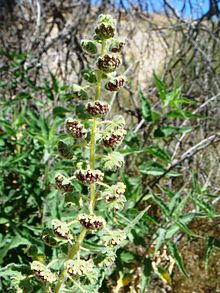- Ambrosia ambrosioides
-
Ambrosia ambrosioides Ambrosia ambrosioides, South Mountain, Phoenix, Arizona Scientific classification Kingdom: Plantae (unranked): Angiosperms (unranked): Eudicots (unranked): Asterids Order: Asterales Family: Asteraceae Genus: Ambrosia Species: A. ambrosioides Binomial name Ambrosia ambrosioides
(Cav.) PayneAmbrosia ambrosioides, also known as canyon ragweed or chicura is a ragweed found in the deserts of northern Mexico and ranging into the southern half of Arizona.
Growing as a shrub from 1-2 meters high, its elongate, coarsely-toothed leaves range from 4-18 cm long and 1.5-4 cm wide. It is monoecious, with both terminal and axillary racemes consisting of staminate heads occurring above their pistillate counterparts. Flowering occurs mainly in February through April. The fruits are 10-15 mm burs covered with hooked spines.
Somewhat similar in appearance to Ambrosia ilicifolia, A. ilicifolia has sessile leaves with a reticulate pattern of veins, and the marginal teeth developed into short spines.
This ragweed can be found in sandy washes and other disturbed areas such as roadsides, and is sometimes seen growing in rock crevices.
Although widespread in the Mexican and Arizonan parts of the Sonoran Desert, it seems not to occur in California; Munz reported it near San Diego, California, but no specimens have been vouchered. Its northern limit is governed by winter frosts.
The Seri people smoked its dried leaves, and used the roots to make medicinal teas and pigments.
References
- Felger, Richard; Mary B. Moser. (1985). People of the desert and sea: ethnobotany of the Seri Indians. Tucson: University of Arizona Press.
- Raymond M. Turner, Janice E. Bowers, and Tony L. Burgess, Sonoran desert plants: an ecological atlas (Tucson: The University of Arizona Press, 1995) pp. 75-76
External links

This Heliantheae article is a stub. You can help Wikipedia by expanding it.

